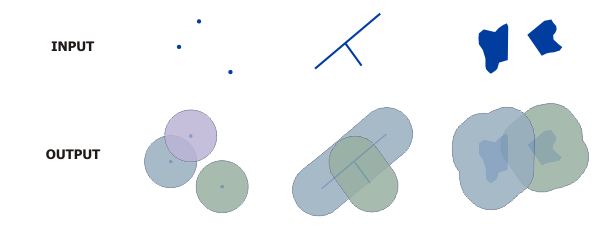Summary
The Buffer Creator Processor can be used to dynamically create a buffer around an event record’s geometry.
Illustration

Examples
- Generating a buffer around aircraft in-flight can be used as one mechanism to ensure proper distances are maintained in respect to critical sites or other no-fly zones on the ground.
- A buffer placed around a facility can be used as a geofence for alerting when vehicles or personnel are near the facility.
- Creating buffers around vessels can be used as one method for ensuring safe distances are maintained in narrow transit corridors. Touching or intersecting buffers can be used to indicate that two vessels are too close to one another.
Usage notes
- The Buffer Size parameter is specified as a positive integer value.
- The processor requires the field containing the event record’s geometry be specified. A geometry field name can be specified, or the GEOMETRY tag can be applied to a field in a GeoEvent Definition to identify the geometry field.
- The Geometry Field parameter will show the name of every field from every GeoEvent Definition containing a data type of geometry. When selecting the geometry field by name, choose the name of the correct geometry field that corresponds to the event record’s GeoEvent Definition.
- The processor can be configured to either replace the event record’s geometry with the computed buffer or place the computed buffer into a new geometry field using the Replace Geometry parameter. Altering an event record's schema by adding a new field requires GeoEvent Server to create a new GeoEvent Definition. The new GeoEvent Definition will be managed by GeoEvent Server and deleted if changes are made to the processor or the GeoEvent Service in which the processor is used.
- Choosing Yes for the Tag the New Geometry Field as Geometry parameter explicitly tells GeoEvent Server which geometry field should be treated as the event record’s realized geometry for subsequent processing or output.
- When sending event records from the processor to a feature service output, ensure only one geometry field exists in the outbound GeoEvent Definition.
- The Buffer Size Units parameter shows a variety of available linear units. Additional units of measure can be displayed and used by modifying the Allowed units list in GeoEvent Manager’s global settings.
- A field name from the inbound event record can be specified in place of a static numerical value for the Buffer Size parameter. This enables the optional ability to generate dynamic buffers based on values from the event record’s data.
- The Buffer WKID parameter is used to calculate an accurate distance which is centered on the expected extent of the event record being processed. Buffered event records are then re-projected using the original WKID of the source event record. This ensures accuracy with the distance of the re-projected buffer. For example, if an inbound event record uses WKID 4326 but the actual geometry of the feature is specific to an area in South Carolina, USA, a valid Buffer WKID could be specified as WKID 32133. The resulting buffer geometry output will maintain WKID 4326, however the distance will have been calculated using the spatial reference local to the centered South Carolina region.
Parameters
| Parameter | Description |
|---|---|
| Name | A descriptive name for the processor used for reference in GeoEvent Manager. |
| Processor | The name of the selected processor. |
| Geometry Field | The name of the geometry field or the GEOMETRY tagged field from the inbound event record the processor will use to calculate the buffer. |
| Replace Geometry | Specifies whether to replace the current event record geometry with the geometry of the buffer polygon. The default is Yes.
|
| New Geometry Field Name (Conditional) | The name of the new geometry field where the buffer polygon geometry will be stored. This parameter is shown when Replace Geometry is set to No and is hidden when set to Yes. |
| Tag the New Geometry Field as Geometry (Conditional) | Determines whether the new geometry field created by the processor will be tagged as GEOMETRY. The GEOMETRY tag is used by GeoEvent Server to identify the event record’s realized geometry when multiple geometry fields are present. The default is No. This parameter is shown when Replace Geometry is set to No and is hidden when set to Yes. |
| New GeoEvent Definition Name (Conditional) | The name assigned to the new GeoEvent Definition. The new GeoEvent Definition will combine the schema of the inbound event record with the additional new geometry field. This parameter is shown when Replace Geometry is set to No and is hidden when set to Yes. |
| Buffer Size Units | The unit of measure used to calculate the buffer. Available linear units include, but are not limited to:
Remarque :Additional units of measure can be displayed and used by modifying the Allowed units list in GeoEvent Manager’s global settings. |
| Buffer Size | The size of the buffer created by the processor. The buffer size can be specified using either a numerical value or using a field name string from the inbound event record GeoEvent Definition. There is no default for this property. |
| Buffer WKID | The well-known ID (WKID) of the spatial reference used to calculate the distance of the buffer before being projected into the source WKID. The resulting buffer geometry maintains the WKID of the source event record. |
Considerations and limitations
- GeoEvent Server does not support buffers measured in angular units (for example, decimal degrees).
- Consider replacing the existing event record geometry with the buffer geometry prior to sending the event data to a feature service. Feature services only support one geometry type field, so whichever field has not been tagged as GEOMETRY will be converted and kept as a string.
Vous avez un commentaire à formuler concernant cette rubrique ?